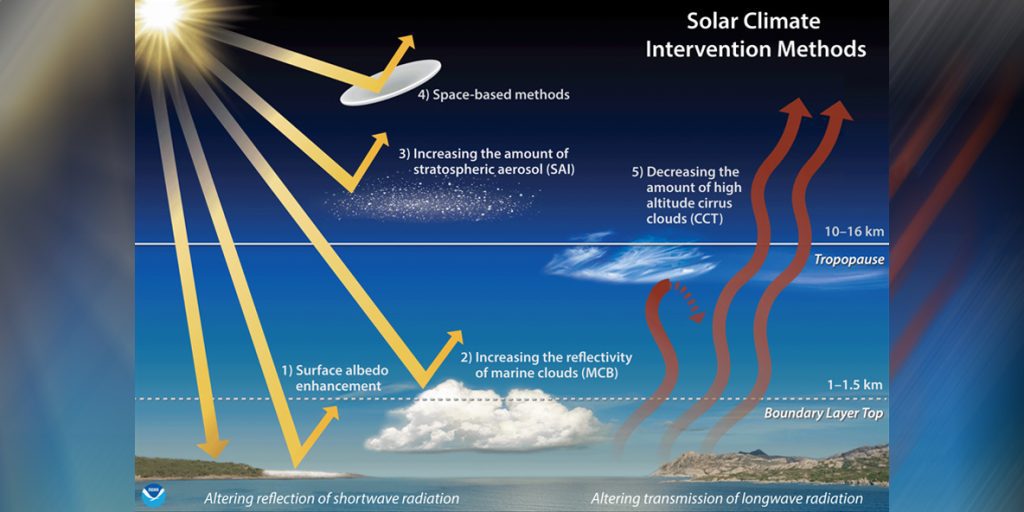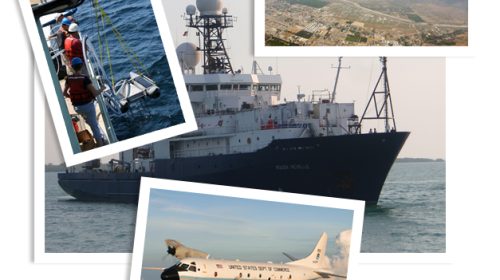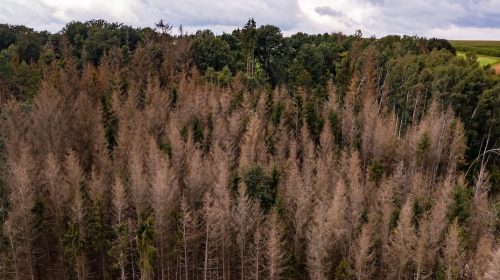CPO’s Earth’s Radiation Budget (ERB) Program is announcing 6 new 3-year projects in Fiscal Year (FY) 2022 that aim to improve the model representation of aerosols and their roles in solar radiation management. The competitively selected projects total $4.2 million in grant awards1.

The ERB Program’s FY22 competition invited proposals focused on improving the representation of stratospheric aerosol injection (SAI) and marine cloud brightening (MCB) in numerical models and using those models to assess the impacts of aerosol perturbations on Earth’s radiative balance, atmospheric chemical processes, dynamics, weather, and climate.
This competition aligns with NOAA research priorities, as directed by Congress, for improving the foundational understanding of atmospheric aerosols and their representation in numerical models, in order to assess potential solar climate intervention approaches. These approaches to temporarily cool the Earth’s surface involve increasing the reflectivity of stratospheric aerosol (as with SAI), or of low-level marine clouds that form over certain ocean regions (as with MCB).
The deployment of climate intervention strategies large enough to offset climate change impacts could have risks and unintended consequences. Many of the processes most important for understanding climate intervention approaches – such as those that control the formation of clouds and aerosols – are among the most uncertain components of the climate system to model and understand. For SAI, the priority is for more accurate model treatments of aerosols in the background stratosphere. For MCB, the priorities are understanding how aerosols interact with marine clouds locally on shorter time scales and how clouds subsequently evolve regionally over longer time periods. Advancing our understanding requires expanded atmospheric observations and modeling, and innovation in our observation and modeling capabilities.
A recent report by the National Academies of Sciences, Engineering and Medicine (NASEM) emphasized the urgency of research into the physical science basis and impacts of these approaches. ERB’s FY22 competition addressed this urgency with a call for projects focused on:
- Improving model representations of stratospheric aerosol processes and the atmospheric chemical, dynamical, and physical responses to aerosol forcing;
- Advancing model treatments of aerosol microphysics, aerosol-cloud interactions and the corresponding impacts on weather, tropospheric chemistry, and climate;
- Assessing with models the efficacy, risks, and Earth System feedbacks of stratospheric aerosol injection (SAI) or marine cloud brightening (MCB).
The six new projects2 funded by ERB in FY22 are:
- Assessing and comparing impacts of solar climate intervention in CESM2 ensembles utilizing strategically located marine cloud brightening and stratospheric aerosol injection
This project will assess and compare the impacts of two different solar intervention strategies using simulations carried out with the Community Earth System Model, version 2 (CESM2) with stratospheric aerosol injection (SAI) and marine cloud brightening (MCB). The project team will use the simulations to identify regions that are particularly sensitive to MCB and SAI and then focus more thoroughly on those regions to understand the changes and how those changes might translate into local consequences such as floods or droughts. Notably, this project will include the first ensemble of simulations with strategically-applied MCB ever produced, where the simulated cloud seeding strategy adjusts in order to maintain a desired climate outcome.- Lead PI: Chih-Chieh (Jack) Chen, National Center for Atmospheric Research (NCAR)
- Co-PIs: Ben Kravitz, Indiana University; Douglas MacMartin, Cornell University
- Assessing the impact of solar climate intervention on hazardous convective weather over the continental United States (CONUS)
This project will produce ensemble convection-permitting regional simulations of convective storms over the contiguous United States driven by large ensembles of climate model simulations in order to achieve three goals: (1) determine how the impacts of stratospheric aerosol injection might influence the occurrence, frequency, and structure of convective storms; (2) quantify the range of uncertainties associated with internal variability and different forcing scenarios on the environments supporting convective storms; and (3) provide a thoroughly tested and evaluated high-resolution, convection-permitting future climate ensemble dataset with and without solar climate intervention for the atmospheric science community.- Lead PI: Lantao Sun, Colorado State University
- A unified framework for assessing the photochemical and energetic impacts of stratospheric aerosols
Understanding how particles will affect earth’s radiation budget both directly, through reflection and absorption of sunlight, and indirectly, through changing photolysis rates and altering atmospheric composition relies on calculations of photolysis rates and irradiance (energy flows). The modeling code scientists commonly use for the two tasks have diverged because they are focused on different variants of the radiation problem. Current practice is to maintain two independent code packages, one for energetic flows and one for photolysis rates. This project proposes to build a modern code for photochemistry by integrating a widely-used package for photolysis rate calculations (Fast-J) into a more modern code for computing irradiance (RTE+RRTMGP). Data will be updated to reflect current understanding of the solar spectrum and its variability, and expanded to provide an example representation of stratospheric aerosols proposed for climate intervention. Development will leverage the open-source practices adopted by RTE+RRTMGP including public repositories for code and data, automated testing, and engagement with the user community. The end result will be a set of closely-related codes that enable the accurate, seamless and self-consistent calculation of the photolysis rates needed for photochemistry and irradiance needed to compute earth’s radiation budget in the presence of stratospheric sulfate aerosols.- Lead PI: Robert Pincus, Lamont-Doherty Earth Observatory at Columbia University
- Co-PIs: Michael Prather, University of California Irvine; Eli Mlawer, Atmospheric and Environmental Research (AER)
- Cloud-resolving simulations of low marine clouds and their response to aerosol perturbations
The fundamental science question behind marine cloud brightening (MCB) as a climate intervention mechanism is whether the reflectivity of marine boundary layer clouds can be deliberately increased in a controlled manner by releasing aerosol particles into the marine boundary layer in targeted regions. The proposed work focuses on quantifying the full range of cloud responses in meteorological regimes under which MCB might be implemented, using realistic background and injected aerosol configurations. This is done through two modeling studies using a Large Eddy Simulation model. These model studies are designed to (a) establish how well the model simulates the evolution of low marine clouds, absent any intervention and (b) systematically explore how low marine clouds respond to realistic MCB aerosol injection schemes for the range of meteorological and background aerosol conditions present in the ambient environment in regions where MCB would likely be most effective.- Lead PI: Sarah Doherty, University of Washington
- Dynamical Downscaling to Quantify Extreme Events Under Stratospheric Sulfate Anerosol Injection
Stratospheric aerosol injection (SAI) describes creating a layer of highly reflective aerosols in the stratosphere, cooling the planet. Nearly all of the available information about SAI is based on global-scale climate models with grid resolutions of 50–100 km. There is presently no reliable method of obtaining local information about the effects and risks of SAI for local decision support, especially for extreme events like floods, droughts, heat waves, and severe storms. This project proposes to use dynamical downscaling to simulate SAI at 3 km resolution to learn (1) how extreme events might change over the 21st century under SAI; (2) the added value of dynamical downscaling of SAI, particularly for representing extreme events, over the U.S. Midwest and the Rocky Mountains; (3) best practices for porting the dynamical downscaling methodology to other regions; and (4) which method of representing SAI best represents complex aerosol microphysics. The proposed work aims to build research capacity on the local level for communities to understand how SAI might affect them, enabling informed decisions, as well as providing information about best practices for representing SAI in regional and forecast models.- Lead PI: Ben Kravitz, Indiana University
- Co-PI: James Hurrell, Colorado State University
- Validation of the CESM2/CARMA size-resolving aerosol model and assessment of aerosol climate intervention methods
To understand the full range of stratospheric aerosol injection (SAI) impacts on the climate system, comprehensive Earth System Models are needed to simulate various processes and feedbacks affected by such applications. However, there are large uncertainties in our understanding of the impacts and risks of different SAI methods. NCAR is developing a version of the Community Earth System Model, version 2 (CESM2) earth system model that includes the option to couple the atmospheric model with the Community Aerosol and Radiation Model for Atmospheres (CARMA) framework, which includes a more sophisticated size-resolving aerosol model. Following the evaluation and tuning of the currently developed CESM2/CARMA model, the proposed work will validate additional configurations of CESM2/CARMA required for SAI studies and explore the effects of two different SAI approaches: sulfur injections in the tropical stratosphere between 20-25 km, and solar powered lofting, a method that requires injections of aerosols at around 14 km in the tropical troposphere. The proposed work will provide new and important information on potential shortcomings and uncertainties of SAI methods and their impacts on the climate systems and will help reduce uncertainties in our future climate projections.- Lead PI: Simone Tilmes, National Center for Atmospheric Research (NCAR)
1The funding will be distributed over the life of the projects and future-year funding is conditional on appropriations.
2 At the time of publication, all awards may not have been accepted by recipient institutions





